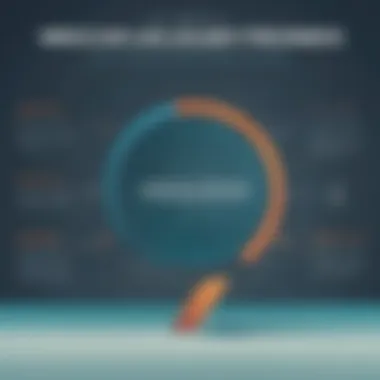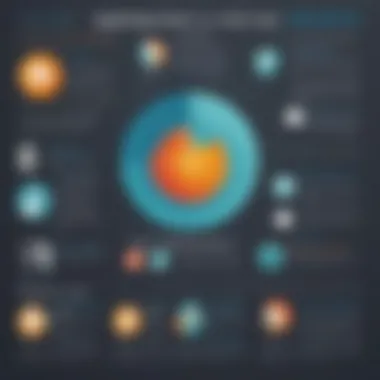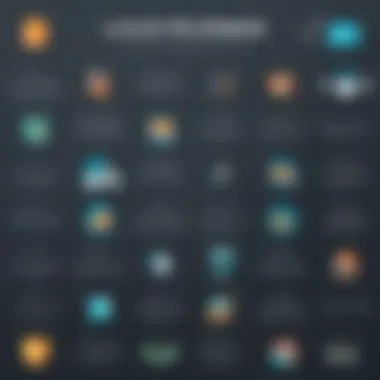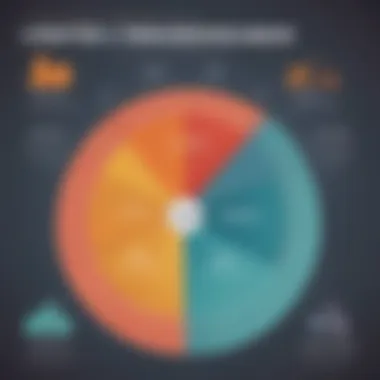Navigating Great Lakes Loan Forgiveness Options


Intro
Navigating the labyrinth of student loans can feel like one of life’s toughest challenges. Among the many names in the loan servicing arena, Great Lakes stands out, offering borrowers pathways to potential relief through loan forgiveness programs. For many, this opportunity isn't just a comforting thought; it's a lifeline that could reshape their entire financial future. Understanding how Great Lakes loan forgiveness works, and what it requires from you as a borrower, is critical in easing the burden of student debt.
Loan forgiveness isn’t a one-size-fits-all solution, and it’s essential to break down the intricate specifics involved. Many students and recent graduates might be confused about eligibility, processes, and common myths surrounding the program. Others might harbor misconceptions that could lead to missed opportunities. The broader implications touch not just on financial health but also on a borrower’s overall lifestyle, career prospects, and mental well-being.
As we delve deeper into the mechanics of this program, we will uncover vital information that can help you make more informed decisions about your loans. We’ll start by defining some key financial terms associated with loan forgiveness, demystifying the often-overlooked language that surrounds financial products. This foundation will pave the way for a clearer understanding of the eligibility criteria and application processes that follow, ultimately leading to practical steps you can take to maximize your benefits and lay the groundwork for a financially literate future.
It’s time to peel back the layers and explore Great Lakes loan forgiveness, ensuring you don’t miss out on the aid that could set you on a path to financial freedom.
Foreword to Loan Forgiveness Programs
Grasping the concept of loan forgiveness is pivotal for anyone navigating the waters of educational debt. The facets of this program directly impact thousands of borrowers who find themselves staring down daunting balances. Understanding the ins and outs of these forgiveness options can lead to significant financial reprieve, paving the way towards a sturdier fiscal future.
Defining Loan Forgiveness
Loan forgiveness generally refers to the cancellation of a borrower's responsibility to repay a certain amount of their loans. In the context of educational loans, this means that for borrowers who meet specific criteria, a portion or even all of their loans can be forgiven. It’s vital to recognize that loan forgiveness isn’t just a wand waved by a fairy godmother—there are rules and regulations, often tied to public service or repayment plans.
Imagine a nurse working tirelessly in a low-income hospital. If she fulfills her obligations over a designated period, that hefty student loan could become a ghost of her past, thanks to forgiveness. However, misconceptions abound. Many borrowers mistakenly believe that forgiveness comes easy or that all loans qualify. The reality is often more nuanced and requires comprehension of the various programs available, such as Public Service Loan Forgiveness or Teacher Loan Forgiveness.
Importance of Understanding Forgiveness Options
Knowing your options isn’t just about having a checklist; it’s essential to make decisions that can steer your financial ship towards calmer seas. Take, for instance, those individuals who might be eligible for specific programs but overlook critical details in the application process. They could end up sinking under the weight of their loans unnecessarily.
"Knowledge is power, especially regarding finances," many say, underscoring the need for a comprehensive understanding.
Moreover, by equipping oneself with this understanding, it's possible to develop strategies that align with long-term financial goals. Factors to weigh include:
- Eligibility criteria: Each forgiveness opportunity has its own set of requirements.
- Impact of repayment plans: Different plans can affect the overall amount forgiven.
- Tax implications: Some programs may treat forgiven loans as taxable income, which can hit you out of the blue.
By getting into the nitty-gritty, borrowers can navigate the often convoluted world of loan forgiveness with more confidence and reach the goal of alleviating their financial burden. Understanding these elements sets a solid foundation for those eager to reclaim their financial lives.
Great Lakes Educational Loan Services Overview
When it comes to navigating the often murky waters of student loans, having a solid understanding of loan servicers like Great Lakes Educational Loan Services can make a world of difference. This section aims to dissect the role that Great Lakes plays in the broader landscape of educational financing, and why it’s vital for borrowers to recognize their significance in the loan forgiveness journey. With various services at their disposal, Great Lakes has the potential to ease financial burdens, making the exploration of its offerings paramount for anyone dealing with student loans.
History and Mission
Great Lakes Educational Loan Services has been a key player in the student loan servicing sector since its inception. Originally founded in the late 1970s, Great Lakes has consistently aimed to foster educational achievement by making loan repayment manageable for borrowers.
The mission of Great Lakes can be summarized as follows:
- Support: They focus on offering personalized support to borrowers throughout their loan lifecycle.
- Education: They believe in educating borrowers about loan options and responsibilities, empowering them to make sound financial decisions.
- Accessibility: The organization aims to make financial education accessible, aiming to reduce confusion and misinformation often surrounding student loans.
Over the decades, Great Lakes has adapted to changes in legislation and borrower needs, proving to be resilient and committed. Their historical foundation plays a crucial role in shaping their present operations and the services available to borrowers today.
Types of Loans Serviced
Great Lakes Educational Loan Services manages a variety of loan types, which can greatly impact the loan forgiveness options that may be available to borrowers. Understanding these different loans is crucial for anyone considering the forgiveness aspect, as certain loans come with different eligibility standards and forgiveness potential.


Here’s a breakdown of the types of loans Great Lakes services:
- Federal Direct Loans: These are government-backed loans with options for income-driven repayment plans and potential loan forgiveness.
- Federal Family Education Loans (FFEL): Though no longer issued, existing FFEL loans can offer ways to seek forgiveness as well.
- Private Loans: While these typically don’t have the same forgiveness options, Great Lakes provides services that help borrowers manage repayment strategies.
Understanding how each loan type figures into the landscape of loan forgiveness is essential. A borrower who knows which category their loan falls under can effectively chart a path toward potential forgiveness, thus alleviating financial stress.
Eligibility Criteria for Loan Forgiveness
Understanding the eligibility criteria for loan forgiveness is paramount for borrowers seeking to alleviate their financial burden. This section not only identifies who qualifies but also sheds light on the significance of these parameters in the pursuit of financial serenity. The importance cannot be overstated; knowing whether you fit the criteria allows for informed decision-making that directly impacts financial planning and future stability.
Types of Eligible Borrowers
Loan forgiveness programs often cater to specific groups of borrowers, each with distinct qualifications. Here’s a closer look at the various categories of those who might be considered eligible:
- Teachers, especially those in low-income areas, can often benefit from forgiveness schemes like the Teacher Loan Forgiveness program. Their commitment to education and community development is highly valued.
- Healthcare workers such as nurses and doctors who work in underserved areas may find relief through programs tailored to their field, like the National Health Service Corps program.
- Public service employees who dedicate their careers to government or non-profit work, often see loan forgiveness options under the Public Service Loan Forgiveness regime.
- Veterans may have specific pathways to forgiveness based on their service, offering them a much-needed reprieve.
Ultimately, being classified under one of these categories can significantly influence the loan forgiveness process, hopefully spreading some financial relief to those who serve the community or the nation.
Specific Loan Types and Conditions
Different loan types come with unique conditions that dictate eligibility for forgiveness. It’s crucial to understand these differences, as they can ultimately guide a borrower’s strategy:
- Federal Direct Loans: Most forgiveness programs favor federal loans. If you're fortunate enough to have one of these, you're already a step ahead.
- Federal Family Education Loans (FFEL): Limited forgiveness options exist for these loans, but consolidation into a Direct Loan may open up pathways.
- Perkins Loans: For those holding Perkins Loans, specific conditions apply, especially with regard to service in certain areas or professions.
In addition to loan types, several other conditions are critical:
- Employment Status: Borrowers need to be actively employed in qualifying jobs to take advantage of forgiveness benefits.
- Payment History: Regular on-time payments for a set period may be required before the full amount of forgiveness is granted.
- Loan Status: Loans must typically be in good standing; defaults can complicate or nullify eligibility.
Understanding these criteria opens a path not just to potential forgiveness but paves the way to a more sober financial future. Taking the time to inspect your standing and options may just lead to a dramatically reduced student debt burden.
In essence, comprehending who qualifies and the specifics surrounding loan types can guide borrowers through the often complicated landscape of loan forgiveness. An informed borrower is an empowered borrower.
Application Process for Great Lakes Loan Forgiveness
Navigating the application process for Great Lakes loan forgiveness is crucial for borrowers seeking relief from their student debt. Understanding the steps involved can not only facilitate a smoother journey but also empower individuals to take charge of their financial future. Applying for loan forgiveness is not merely about filling out forms; it's about strategically putting into place all required documentation to ensure the best chances of approval.
When you know the application process like the back of your hand, you’re likely to minimize any potential hiccups along the way. Just having the knowledge of what to expect can alleviate anxiety, allowing you to focus on fulfilling the requirements efficiently.
Step-by-Step Application Guide
- Do Your Homework: Before you even think about applying, it's wise to research the specific forgiveness program you are targeting. Whether it's Public Service Loan Forgiveness or another option, understanding the criteria and particulars of each one is vital.
- Gather Necessary Information: Make sure you have your financial information, loan details, and job history ready. This information will serve as the backbone of your application.
- Complete the Application Form: Fill out the required application form accurately, ensuring all fields are correctly completed to avoid delays. This typically includes providing personal and loan information, alongside employment eligibility verification if applicable.
- Submit Supporting Documents: Alongside your application form, supporting documentation is crucial. This may include income statements, proof of employment, and perhaps even tax documents depending on the type of forgiveness you are seeking.
- Follow Up: After submitting, it’s important to keep tabs on your application status. This helps you respond promptly to any additional requests from your loan servicer.
- Await Decision: Finally, be patient. Decisions can take time, so while waiting, continue to manage your current payments if applicable.
Common Documentation Requirements
Being aware of the documentation that is typically needed can streamline your application process. Here’s a list of common documentation requirements:
- Proof of Income: Pay stubs or tax returns to verify your current income will often be necessary.
- Loan Statements: You may be asked to provide statements for your federal loans to verify balances and payment history.
- Employment Verification: Documentation from your employer that proves your employment and role, especially for those seeking Public Service Loan Forgiveness.
- Federal Tax Returns: This may also be required to corroborate income and employment history, especially if you're applying based on financial hardship.
- Identification Documents: More often than not, a government-issued ID will be a must to confirm your identity.
Keeping organized records can significantly ease your stress and enhance the chances of successful loan forgiveness.


Ultimately, applying for Great Lakes loan forgiveness can seem daunting, but with proper preparation and understanding of each step, you can tackle it with confidence. Always remember to check for any specific requirements associated with your loan type or the forgiveness program you are applying under.
Impact of Loan Forgiveness on Financial Health
The concept of loan forgiveness can wield significant influence on an individual's financial situation. For many borrowers navigating the tumultuous seas of student debt, understanding how loan forgiveness impacts financial health becomes vital. It is not merely about erasing a sum from an account; it encompasses long-term financial stability, mental health, credit scores, and future financial opportunities.
In this section, we’ll break down the immediate gains that a borrower might see as well as the implications it could have in the longer run. Both factors together shape the borrower’s overall financial outlook.
Short-Term Benefits
When a borrower successfully qualifies for loan forgiveness, the immediate effects can be quite beneficial. Here's how:
- Reduction of Debt Burden: The most obvious advantage is the relief from the burden of student debt. With loans canceled, the weight of monthly payments disappears, instantly freeing up income for other expenses.
- Improvement in Cash Flow: Without the need to allocate funds toward student loan repayments, an individual can redirect this money into savings, investments, or necessities. This newfound flexibility often allows for better budgeting and financial planning.
- Psychological Relief: The feeling of being freed from debt can bring peace of mind, which has been shown to enhance overall well-being and focus. Less stress can lead to better productivity at work or in studies, allowing for a virtuous cycle of improvement.
"Loan forgiveness doesn’t just wipe the slate clean; it can rejuvenate the spirit and help borrowers feel like they can finally breathe again."
However, it’s important to realize that these short-term benefits often lay the groundwork for the longer-term implications that follow.
Long-Term Financial Implications
The long-term effects of loan forgiveness carry a weight of complexity, often reshaping a borrower’s financial landscape:
- Impact on Credit Scores: The cancellation of debt can lead to an improvement in a borrower’s credit score, as credit utilization ratios are often lower for those without heavy student loan balances. An elevated score can facilitate better rates on future loans, such as mortgages or car financing.
- Opportunities for Investment: With a decrease in debt loads, individuals may become more inclined to make investments. This could be in personal development, real estate, or even starting a business. The extra funds that were once earmarked for loan repayments can now fuel aspirations that provide returns.
- Changes in Career Choices: The prospect of loan forgiveness can influence career decisions. Knowing there’s a possibility of debt cancellation, many individuals may choose jobs in public service or lower-paying sectors that offer a path to forgiveness instead of chasing higher salaries.
- Financial Literacy Growth: Engaging with loan forgiveness often brings people into the realm of financial education, either by necessity or by choice. The more individuals learn about managing money, budgeting, and investments, the better positioned they are for a secure financial future.
In essence, while the immediate relief from financial pressure is invaluable, it’s the ongoing changes that will shape an individual’s financial trajectory in the years to come. Understanding both sides is crucial for anyone contemplating the implications of loan forgiveness.
Challenges and Misconceptions
Understanding the landscape of loan forgiveness, particularly through Great Lakes Educational Loan Services, often comes with a fair share of challenges and misconceptions. It is crucial to address these areas as they significantly influence how individuals perceive and navigate their journey toward potential debt relief. Not everything that glitters is gold, and the allure of forgiveness programs may come paired with complexities that could mislead borrowers if not properly understood.
Common Myths About Loan Forgiveness
One would think that loan forgiveness is a straightforward process, but many assumptions abound. Here are some prevalent myths that need busting:
- Myth 1: All loans can be forgiven.
Many borrowers might believe that simply applying for loan forgiveness is enough to erase all their student debt. In reality, only specific types of loans qualify for forgiveness programs, often contingent upon the borrower's profession, repayment plan, and other factors. For instance, Federal Direct Loans are commonly eligible, while private loans typically are not. - Myth 2: Forgiveness happens overnight.
Some individuals expect immediate results upon application. The truth is, the forgiveness process can take years and often requires extensive documentation and adherence to strict guidelines. Patience is key. - Myth 3: Eligible borrowers only include teachers or public service workers.
While many of the most touted forgiveness programs favor public service careers, various opportunities exist across different sectors, including healthcare and nonprofit work. Each program holds its eligibility criteria that could surprise borrowers regarding inclusivity.
"Understanding the specific requirements tied to loan forgiveness is half the battle. Clear misconceptions can prevent enforcing the right strategies for financial health."
Potential Drawbacks and Limitations
While the gleam of loan forgiveness is attractive, potential drawbacks can tarnish that shine. Acknowledging these limitations is essential in crafting an educated approach to financial well-being:
- Limitations in Financial Planning.
Borrowers might put all their eggs in the forgiveness basket, only to discover too late that they needed to consider additional repayment strategies or financial planning aspects. The idea of loan forgiveness could lead to complacency, which might affect long-term financial health. - Confusion in Guidelines.
Each forgiveness program, including those through Great Lakes, comes with its own set of rules. Misdirection or misunderstanding of these guidelines can lead to disqualification, which is often too late to rectify without proper foresight. Therefore, staying informed is crucial. - Tax Implications.
In some cases, forgiven amounts may be subject to taxes. Borrowers may rejoice in debt relief, but once tax season rolls around, they could find themselves with unexpected tax liabilities. It is wise to consult a tax advisor when considering options.
Ultimately, the hurdles and myths surrounding loan forgiveness demand a critical eye. A true understanding of these elements can empower borrowers to make informed decisions regarding their financial futures.
With such nuanced topics at play, being well-versed can be your best ally as you navigate this complex world.
Enhancing Financial Literacy in Loan Forgiveness Context


Understanding loan forgiveness, especially within programs like those offered by Great Lakes, requires a nuanced appreciation of financial literacy. Financial literacy is more than just knowing numbers; it’s about understanding how money works, how loans function, and how debt can impact one’s long-term financial health. In the context of loan forgiveness, being financially literate empowers individuals to make informed decisions.
A significant benefit of enhancing financial knowledge is the ability to demystify the often convoluted processes surrounding loan forgiveness. Borrowers, equipped with the right resources, are better able to navigate eligibility criteria, application protocols, and the potential outcomes of these programs. This savviness isn’t just a luxury; it’s essential for ensuring that borrowers take appropriate steps to maximize their benefits, ultimately alleviating some of the burdens that come with educational debt.
Moreover, fostering a deeper understanding of personal finance helps in distinguishing between myths and facts about loan forgiveness. For instance, many believe that all loans can simply be forgiven without consequence. In reality, specifics matter greatly. By learning about various forgiveness programs, borrowers can avoid common pitfalls that could end up complicating their financial lives further.
"Financial literacy isn’t just a skill; it’s the key to unlocking a successful financial future."
Educational Resources and Tools
Several educational tools exist to enhance financial literacy for those interested in loan forgiveness. Online platforms, such as the Federal Student Aid website or resources provided by Great Lakes, offer useful information about the types of loans eligible for forgiveness and specific requirements. Here are some essential tools and resources:
- Financial Education Websites: Websites like en.wikipedia.org and britannica.com provide articles that explain financial concepts in layman's terms.
- Webinars and Workshops: Participating in educational webinars and workshops can provide direct access to experts in student finance and loan forgiveness.
- Interactive Calculators: Tools for estimating loan repayments, potential forgiveness amounts, and financial impact can help to visualize scenarios and make informed decisions.
- Social Media Groups: Joining discussions on platforms like facebook.com and reddit.com can introduce various perspectives and experiences on managing education loans.
Each of these resources serves as building blocks for developing a sound understanding of financial concepts, especially in the realm of loan forgiveness, enabling borrowers to take control of their financial futures.
Importance of Financial Advisory Services
While self-education is crucial, the complexity of loan forgiveness programs often warrants additional assistance. This is where financial advisory services shine. These professionals can offer personalized guidance, tailoring advice to suit individual circumstances and financial goals.
The role of financial advisors in the context of loan forgiveness can be pivotal:
- Personalized Strategy Development: They help craft a tailored approach to managing student debt, ensuring borrowers are on the right track toward forgiveness.
- Navigating Complexities: With the regulations and requirements constantly evolving, advisors remain updated, aiding borrowers in making timely and beneficial choices.
- Long-Term Planning: Beyond loan forgiveness, advisors can assist in wider financial planning, helping borrowers understand how forgiveness fits into their overall financial well-being.
In summary, while educational resources provide foundational knowledge, financial advisors bring expertise and personalized strategies to the table. Together, they enhance financial literacy, empowering borrowers in their journey toward greater financial stability.
Culmination and Next Steps
As we reach the end of this exploration into Great Lakes loan forgiveness, it’s crucial to underscore the significance of this topic. Understanding the nuances of loan forgiveness isn’t just a box to check off—it’s about securing financial freedom and making informed choices for your future. Whether you’re a student just starting on your educational journey or someone grappling with existing debt, knowing your options is paramount.
Reflecting on Individual Circumstances
Every borrower’s situation is as unique as a snowflake, laden with distinct challenges and opportunities. It’s essential to take a step back and carefully evaluate your own financial landscape. Ask yourself questions that matter: Are you eligible for programs? What’s your long-term goal regarding education and career? Have you calculated the total debt burden?
- Personal Assessment
- Future Planning
- Review your current debts and repayment plans.
- Consider your eligibility for forgiveness based on your career path.
- Analyze your financial and emotional readiness to commit to a repayment strategy.
- What do you envision in your career?
- Set financial goals that align with that vision.
- Keep an eye on changes in policies that may affect your options.
Taking the time to reflect on these aspects helps keep a clear head amidst the fog of student loans and repayment. It’s your life, after all; ensuring your decisions fit your own narrative is invaluable.
Moving Towards Financial Empowerment
Empowerment stems from knowledge and action. Armed with the right information about Great Lakes loan forgiveness, you’re not just reacting anymore; you can proactively navigate your financial destiny. The goal is to use this understanding not just as a safety net but as a springboard to further personal and professional development.
- Access available resources
- Stay informed and adaptable
- Seek out financial literacy workshops or webinars.
- Consult trusted financial advisors who can tailor strategies based on your individual situation.
- Regularly check for updates on loan forgiveness programs.
- Join forums or communities—Reddit is a good platform—to exchange information and resources with others in similar situations.
"Knowledge is not only power; it’s also the key to unlocking opportunities for a brighter financial future."
Taking ownership of your financial journey doesn’t happen overnight, but each step forward unlocks the door to greater autonomy and satisfaction. Remember, the aim is not just to eliminate debt, but to empower yourself to seize the full breadth of opportunities life has to offer.







